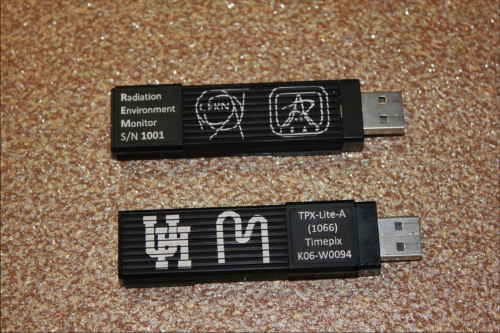Chips with everything

It looks just like a memory stick but that is where the similarity ends. Inside, the tiny black box is far more sophisticated, contains considerably more technology and is offering a revolution in space dosimetry. The tiny device is just one of many applications for a pixel detector technology developed at CERN.
Back in the 1980s integrated circuit technology was in its infancy. CERN's Erik Heijne suggested that it could be adapted to create a new kind of radiation detector. His vision was to pack all the electronics required to process the signals from a radiation sensor into a 1mm square of silicon. By building up an array of these tiny circuits on the top surface of a single electronics chip, and connecting each circuit to its own equally tiny sensor element on a matching sensor chip using a flip chip process, you would have a new type of 'hybrid' pixel detector.
Erik had set a considerable challenge; at the time, the electronics required for a standard multi-channel radiation sensor would have occupied the size of a bookshelf.
That challenge was picked up by a team of physicists and engineers including Michael Campbell, a then recent recruit to CERN and an alumnus of Strathclyde University. "Pixel detectors didn't exist," he says, "so we not only had to prove that they could be built, but also that they would work for particle physics".
Twenty years after the publication of Erik's paper, the first data were collected by the LHC's pixel detector systems.
During the development of the detectors in the early 90s, it became apparent to Michael and his colleagues that their new technology had applications outside high energy physics. They had tested the sensors using radioactive sources, and sometimes experimented by putting objects between the sensor and the source to produce an X-ray image.
The results were a bit rough and ready, but they had established that you could potentially detect individual X-rays, pixel by pixel, and measure their energy. They had the idea that by adding camera logic to each of the pixels (where each pixel is able to detect incoming particles over a pre-defined time frame) you could create an image from the number of pixel 'hits'. The idea was followed up by the team at CERN in collaboration with groups in Germany, Italy and Scotland, and the Medipix1 chip was born.
Whilst the technology showed potential for detecting low energy X-rays commonly used in mammography and therefore minimising radiation dose to the patient, more work was needed; the pixel size of 170?m was considered too large, and the number of pixels on the chip (64 x 64) too low.
Technology develops at a furious pace, and in 1999 a new collaboration was formed with the goals of reducing the pixel size to ~50µm and creating a 256 x 256 array. The collaboration also set itself the challenge of creating colour images by adapting the pixel sensors to detect the energy of the X-rays, not just their presence.
The Medipix2 chip - which counts particles which deposit energy in a pixel within a pre-defined energy window - was unveiled in 2002. Following some refinements to the chip in the following years, the chip, the technology was picked up by an international group working on gas detectors (the EUDet Collaboration) in 2005. The developments that they required (making each sensor record the precise arrival time of the particle) led to the creation of the Timepix chip.
Michael and his colleagues are currently testing the Medipix3 chip. Taking the technology a step further, this chip is addressing the issue of how to identify and calculate the energy from single X-ray particles when the charge is spread unevenly over several neighbouring pixels.
"We think that spectroscopic X-ray imaging based on this technology could complement PET", explains Michael. "It's a cheaper technology and could be made available in more hospitals. There are still a number of big challenges to scaling up the technology but if you think something is possible, you should definitely try!"
And what about the other applications? Space dosimetry is just one of many; thanks to the efforts of teams at the Institute of Experimental and Applied Physics (IEAP) in Prague and the University of Houston, five devices the size of a memory stick are currently monitoring the exposure of astronauts on the International Space Station to ionising radiation. Simpler, smaller and lighter than existing monitoring technology, the devices have attracted interest from NASA and ESA.
The IEAP group has also used the chips to film parasites invading the eggs of leaf miners and metamorphosing into wasps. Other teams are studying the growth of graphene flakes on a surface, developing new high resolution gas detectors or producing lightweight, sensitive imaging systems that can be used to monitor radiation when decommissioning nuclear installations.
An instrument using five Timepix chips devised by a team from Canterbury in Kent will shortly be launched into space on the TechdemoSat satellite to study cosmic radiation and help predict the occurrence of solar flares (proton storms) which disrupt artificial satellites.
What makes the experiment unusual is that the team comprises students from the Simon Langton Grammar School, and all the data from the instrument will be made available to other schools via the LHC's computing GRID. The students' interest in Timepix arose from a visit to the Medipix lab back in 2006.
The potential of the Medipix/Timepix technology seems limitless. "With each generation of chip, we're putting more brains inside the pixels" says Michael. "Medipix makes friends in other research fields– it's taking particle physics detector technology into new places."
Provided by Science and Technology Facilities Council





















